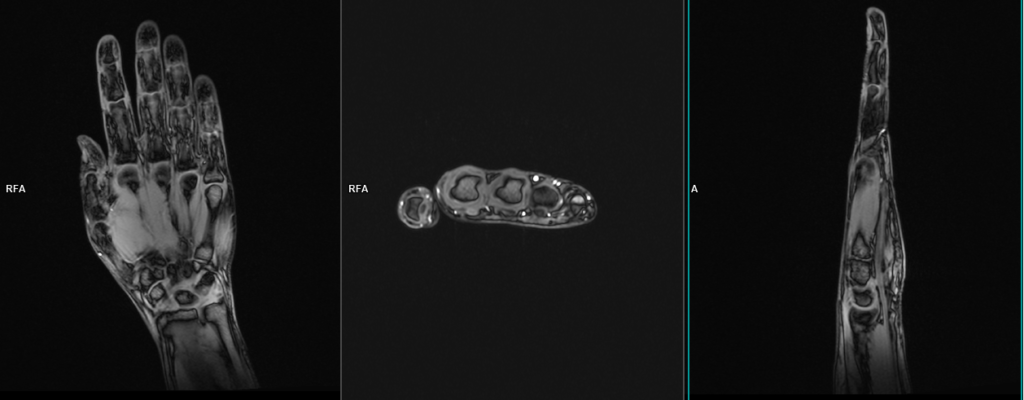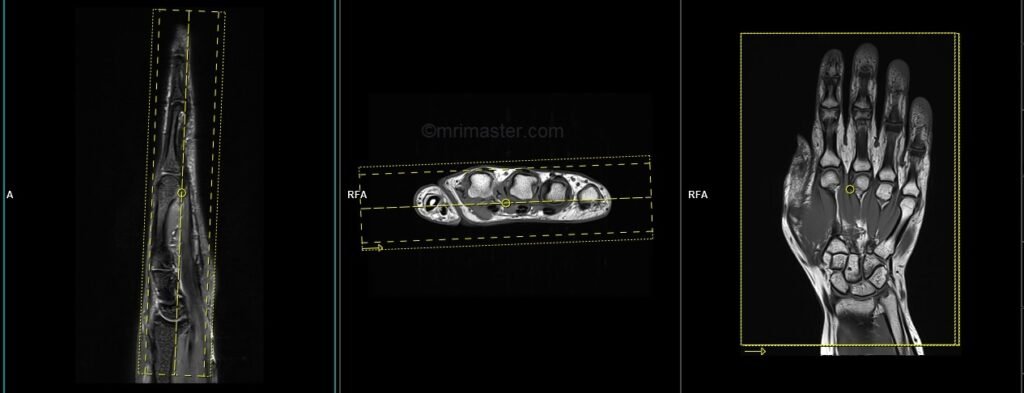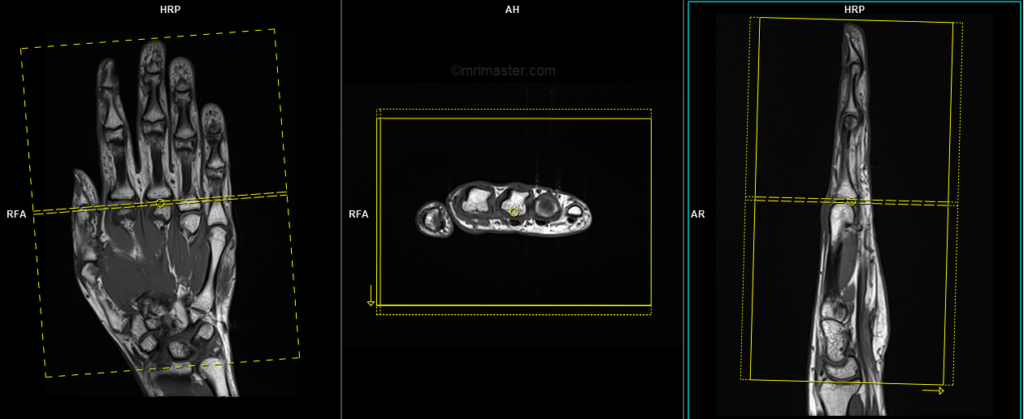TWIST\TRICKS Dynamic MRA Hand
TWIST (Time-resolved Angiography With Interleaved Stochastic Trajectories) MRA
TWIST (Time-resolved Angiography With Interleaved Stochastic Trajectories) is an advanced and innovative 3D Magnetic Resonance Angiography (MRA) technique that offers exceptionally high temporal (sub-second) and spatial resolution (sub-millimeter). This unique capability allows for the acquisition of multiple arterial, mixed, and venous phase images, capturing the passage of a contrast agent through the vascular anatomy in real-time.
TWIST MRA is based on a special k-space sampling technique. The k-space, a mathematical representation of image data, is divided into two regions. The central region of k-space provides information related to image contrast, while the peripheral region primarily contributes to achieving high spatial resolution.
The acceleration of the sequence acquisition is achieved by more frequently sampling k-space lines in the center during the passage of the contrast medium bolus through the covered 3D volume. This random and interleaved sampling technique optimizes both temporal and spatial resolution, enabling the real-time visualization of blood flow dynamics and vascular structures.
TWIST MRA is particularly beneficial in pediatric populations with soft-tissue vascular anomalies in the head and neck region. Compared to conventional contrast-enhanced MRI (CE-MRI), TWIST MRA with gadofosveset trisodium, a blood-pool contrast agent, offers detailed temporal information of VA hemodynamics and flow characteristics without the need for invasive procedures.
Indications for MRA hand
- Thrombotic and embolic disease
- Arteriovenous malformation
- Atherosclerotic disease
- Artery dissections
- Vein thrombosis
- Artery stenosis
- Aneurysms
- Vasculitis
- Vasospasm
Contraindications
- Any electrically, magnetically or mechanically activated implant (e.g. cardiac pacemaker, insulin pump biostimulator, neurostimulator, cochlear implant, and hearing aids)
- Intracranial aneurysm clips (unless made of titanium)
- Pregnancy (risk vs benefit ratio to be assessed)
- Ferromagnetic surgical clips or staples
- Metallic foreign body in the eye
- Metal shrapnel or bullet
Patient preparation for TWIST MRA Hand
- A satisfactory written consent form must be taken from the patient before entering the scanner room
- Ask the patient to remove all metal objects including keys, coins, wallet, cards with magnetic strips, jewellery, hearing aid and hairpins
- Contrast injection risk and benefit must be explained to the patient before the scan.
- Gadolinium should only be given to the patient if GFR is > 30
- Intravenous line must be placed in the unaffected side e.g if the problem exists in RT arm the canula should be in LT side
- An intravenous line must be placed with extension tubing extending out of the magnetic bore
- Claustrophobic patients may be accompanied into the scanner room e.g. by staff member or relative with proper safety screening
- Offer headphones for communicating with the patient and ear protection
- Explain the procedure to the patient and answer questions
- Note the weight of the patient
Positioning for TWIST MRA Hand
- Head first prone with arm up (superman position)
- Position the hand in large flex coil and immobilize with cushions
- Give cushions under the chest for extra comfort
- Centre the laser beam localiser over the metacarpophalangeal joint
- Register the patient in the scanner as head first supine

Recommended TWIST MRA Hand Protocols and Planning
Localiser
A three-plane localizer must be taken at the beginning to localize and plan the sequences. Typically, these localizers take less than 25 seconds and can be achieved using T1 weighted low-resolution scans. It is advisable to obtain additional localizers until you have acquired accurate axial, coronal, and sagittal localizer images.

TWIST coronal .8mm 3pre and 30 post
Plan the coronal TWIST 3D block on the axial plane and position the block horizontally across the metacarpal bones. Check the positioning block in the other two planes. An appropriate angle must be used in the sagittal plane, parallel to the metacarpal and phalangeal bones. The slices should sufficiently cover the entire hand, from the dorsal aspect to the palmar aspect. The scan acquisition time should be less than 5 seconds to achieve the best results.

Parameters
TR 4-5 | TE 1.25 | FLIP 14 | NEX 1 | SLICE .8MM | MATRIX 256X256 | FOV 250-300 | PHASE R>L | DYNAMIC 33 SCAN | IPAT ON |
A dynamic TWIST sequence consists of 33 0.8mm 3D scans, with each acquisition taking around 3-4 seconds. The contrast injection must be administered after the third dynamic sequence.
T1 VIBE DIXON 3D fat sat axial 2mm small FOV post-contrast
Plan the axial slices on the coronal localizer and angle the positioning block perpendicular to the metacarpal and phalangeal bones. Check the positioning block in the other two planes. Ensure an appropriate angle is used in the sagittal plane, perpendicular to the metacarpal and phalangeal bones. The slices should adequately cover the entire hand, spanning from the fingertip to the line of the distal radioulnar joint.

Parameters
TR 6-7 | TE 2.39 4.77 | FLIP 10 | NXA 1 | SLICE 2 MM | MATRIX 320×288 | FOV 250-300 | PHASE A>P | OVERSAMPLE 20% | BH NO |


